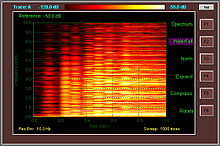
In music, timbre (/ˈtæmbər, ˈtɪm-, ˈtæ̃-/), also known as tone color or tone quality (from psychoacoustics), is the perceived sound quality of a musical note, sound or tone. Timbre distinguishes different types of sound production, such as choir voices and musical instruments. It also enables listeners to distinguish different instruments in the same category (e.g., an oboe and a clarinet, both woodwind instruments).
In simple terms, timbre is what makes a particular musical instrument or human voice have a different sound from another, even when they play or sing the same note. For instance, it is the difference in sound between a guitar and a piano playing the same note at the same volume. Both instruments can sound equally tuned in relation to each other as they play the same note, and while playing at the same amplitude level each instrument will still sound distinctively with its own unique tone color. Experienced musicians are able to distinguish between different instruments of the same type based on their varied timbres, even if those instruments are playing notes at the same fundamental pitch and loudness.[citation needed]
The physical characteristics of sound that determine the perception of timbre include frequency spectrum and envelope. Singers and instrumental musicians can change the timbre of the music they are singing/playing by using different singing or playing techniques. For example, a violinist can use different bowing styles or play on different parts of the string to obtain different timbres (e.g., playing sul tasto produces a light, airy timbre, whereas playing sul ponticello produces a harsh, even and aggressive tone). On electric guitar and electric piano, performers can change the timbre using effects units and graphic equalizers.